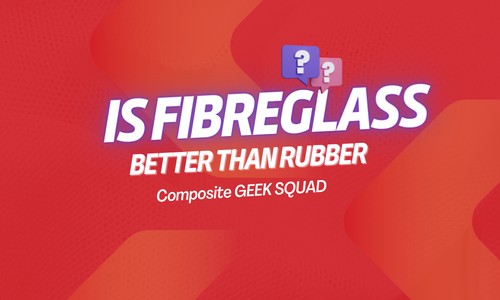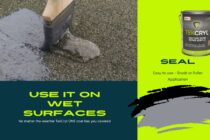Fibreglass vs EPDM
Navigating the Fibreglass vs. Rubber Roofing Dilemma: A Comprehensive Comparison for Informed Decision-Making
Introduction:
As homeowners and builders delve into the vast realm of roofing materials, the debate between fibreglass and rubber roofing solutions emerges as a critical decision. In this exploration, we aim to address the burning question: Is a fibreglass roof superior to a rubber roof? By dissecting the key attributes of each material, including durability, installation ease, and overall performance, this blog seeks to guide you towards an informed choice for your roofing project.

Fibreglass Roofing Benefits:
- Durability: Fibreglass roofs boast exceptional durability, ensuring a lasting solution for diverse roofing needs. The seamless design enhances their ability to withstand weathering and external pressures, contributing to their longevity.
- Aesthetic Versatility: Fibreglass roofs offer a myriad of design possibilities, allowing for customisation that seamlessly aligns with architectural preferences. This aesthetic versatility ensures a harmonious integration with the overall look of your property.
- Weather Resistance: Excelling in weather resistance, fibreglass roofs are ideal for various climates. They can endure extreme temperatures, UV radiation, and harsh weather conditions, promising longevity with minimal maintenance.
- Eco-Friendly Construction: Sustainability is a key focus, and fibreglass roofing materials align with eco-friendly principles. Their recyclability adds to the appeal, contributing to a sustainable approach in modern construction practices.
Rubber Roofing Advantages:
- Cost-Effective Option: Rubber roofing presents a budget-friendly choice, making it attractive for those seeking a cost-effective roofing solution without compromising on quality.
- Ease of Installation: Recognised for their simplicity in installation, rubber roofs contribute to reduced labour costs and shorter project completion times, making them a practical option for projects with time and budget constraints.
- Lightweight Construction: The lightweight nature of rubber roofs proves advantageous in certain construction scenarios, especially for structures with specific weight considerations.
- Flexible and Resilient: The flexibility and resilience of rubber roofing materials make them a suitable choice for buildings in regions prone to structural movements or settling.
Comparative Analysis:
- Durability and Longevity: While both fibreglass and rubber roofs offer durability, fibreglass tends to have a longer lifespan due to its robust and weather-resistant properties.
- Installation Ease: Rubber roofs are often favoured for their ease of installation, making them a practical choice for projects with time and budget constraints.
- Aesthetic Appeal: Fibreglass roofs take the lead in aesthetic versatility, allowing for a seamless blend with diverse architectural styles.
- Cost Considerations: Rubber roofing may have an initial cost advantage, but the long-term durability of fibreglass roofs can result in cost savings over the life of the roof.
Trusted Sources:
- To explore the extensive benefits of fibreglass roofing, consider insights from Green Composites, a reputable supplier of fibreglass roofing kits, resins, topcoats, and tools.
- For a comprehensive range of fibreglass roofing materials and expert advice, visit ResiRoof GRP, a trusted provider in the industry.
- Composite Roof Supplies A reputable supplier of EPDM Rubber roofing kits, primers, contact adhesives, and tools.
Fibreglass vs EPDM, Dilemma: A Comprehensive Roofing Material Comparison
When it comes to roofing solutions, the choice between fibreglass and rubber has become a significant consideration for homeowners and builders alike. Let’s delve into the key aspects of each material to understand the nuances and help you make an informed decision for your roofing project.
Durability of Fibreglass Roofs: Fibreglass roofs are renowned for their exceptional durability. Composed of a plastic matrix reinforced with fine glass fibres, fibreglass creates a robust and resilient roofing material. The seamless design of fibreglass roofs contributes to their ability to withstand various weather conditions and external pressures, ensuring a long-lasting and reliable roofing solution.
Installation Ease: Fibreglass vs. Rubber: While both fibreglass and rubber roofs offer advantages, rubber roofing is often recognized for its ease of installation. The flexible nature of rubber makes it relatively simple to work with, contributing to reduced labour costs and shorter project completion times. For those prioritising a swift and hassle-free installation process, rubber roofing may present a practical option.
Fibreglass Roofing Benefits: Fibreglass roofing comes with a host of benefits that make it an attractive choice for many. Beyond durability, fibreglass roofs offer aesthetic versatility, allowing for customization to match architectural preferences. Weather resistance is another standout feature, making fibreglass suitable for diverse climates. Additionally, the eco-friendly nature of fibreglass, being recyclable, aligns with sustainable construction practices.
Rubber Roofing Advantages: Rubber roofing, on the other hand, stands out as a cost-effective option. Its initial affordability makes it appealing for those with budget constraints. The lightweight construction of rubber roofs is advantageous in scenarios where the overall weight of the roofing material is a critical consideration. Moreover, the flexibility and resilience of rubber contribute to its suitability for structures in regions prone to structural movements.
Longevity of Fibreglass Roofs: In the longevity department, fibreglass tends to have an edge. The robust composition and weather-resistant properties of fibreglass contribute to an extended lifespan, offering homeowners peace of mind with a roofing solution that stands the test of time.
Weather Resistance: Fibreglass vs EPDM: When it comes to weather resistance, fibreglass roofs demonstrate exceptional capabilities. They can endure extreme temperatures, UV radiation, and harsh weather conditions, maintaining their structural integrity and aesthetic appeal over the years. Rubber roofs, while resilient, may not match the same level of weather resistance as fibreglass.
Maintenance Requirements: Fibreglass vs EPDM: Both fibreglass and rubber roofs are known for their low maintenance requirements. Fibreglass roofs, once installed, demand minimal attention, thanks to their durable and weather-resistant nature. Rubber roofs, while requiring less maintenance than some traditional roofing materials, may benefit from periodic checks to ensure longevity.
In conclusion, the choice between Fibreglass vs. Rubber Roofing depends on various factors, including your project priorities, budget considerations, and aesthetic preferences. Fibreglass excels in durability, aesthetic versatility, and weather resistance, making it an ideal choice for those prioritising long-term performance. On the other hand, rubber roofing presents a cost-effective and easy-to-install alternative, catering to specific budget and timeline constraints. Ultimately, understanding the nuances of each material will guide you towards the roofing solution that best suits your unique needs.
#FibreglassVsRubberRoof #RoofingMaterials #DurabilityComparison #HomeImprovement #RoofingChoices #ConstructionMaterials #SustainableRoofing #BudgetFriendlyRoofing #RoofingDebate #EcoFriendlyConstruction
Fibreglass vs EPDM: Q&As
- Q: What is the primary material composition difference between Fibreglass vs EPDM roofing? A: Fibreglass roofing is made from layers of glass reinforced with polyester resin, while EPDM (Ethylene Propylene Diene Monomer) roofing is a synthetic rubber membrane.
- Q: How do Fibreglass vs EPDM roofs differ in terms of installation complexity? A: Fibreglass roofing often requires professional installation due to the intricate layering process, while EPDM roofing can be more straightforward to install and may be suitable for DIY projects.
- Q: What is the average lifespan of Fibreglass roofing compared to EPDM roofing? A: Fibreglass roofs typically have a lifespan of 20-30 years, whereas EPDM roofs can last 40 years or more with proper maintenance.
- Q: How do Fibreglass vs EPDM roofs handle extreme weather conditions differently? A: Fibreglass roofing is known for its durability in harsh weather, while EPDM roofing exhibits excellent resistance to UV rays, making it suitable for sunny climates.
- Q: In terms of repairs, which roofing material is more easily patchable – Fibreglass vs EPDM? A: Fibreglass roofs may require professional repairs, while EPDM roofs are often more easily patchable with DIY repair kits.
- Q: Which roofing material offers better resistance to punctures and tears – Fibreglass or EPDM? A: EPDM roofing is generally more resistant to punctures and tears compared to Fibreglass roofing.
- Q: How do Fibreglass vs EPDM, roofs differ in terms of flexibility and adaptability to roof shapes? A: EPDM roofing is highly flexible and can adapt to various roof shapes seamlessly, while Fibreglass roofing may require more intricate molding for complex designs.
- Q: Which roofing material is more environmentally friendly – Fibreglass vs EPDM? A: EPDM is considered more environmentally friendly as it is a synthetic rubber with a longer lifespan and is recyclable.
- Q: In terms of cost, how do Fibreglass vs EPDM roofing compare? A: Fibreglass roofing can have higher upfront costs, including installation, while EPDM roofing tends to be more budget-friendly, making it a popular choice for cost-conscious homeowners.
- Q: How do Fibreglass vs EPDM, roofs differ in terms of maintenance requirements? A: Fibreglass roofs may require periodic inspections and professional maintenance, whereas EPDM roofs are relatively low-maintenance, needing occasional cleaning and inspections.


